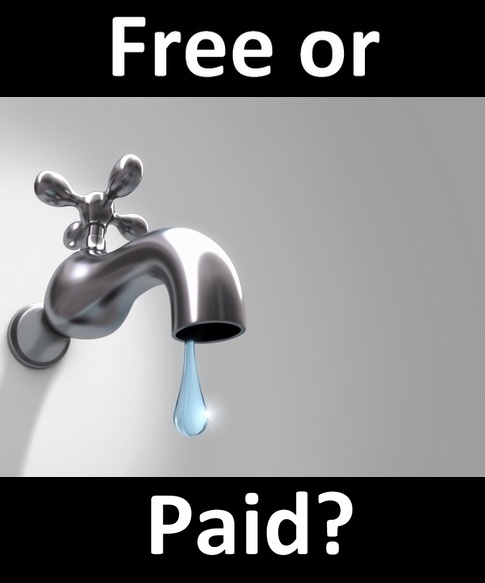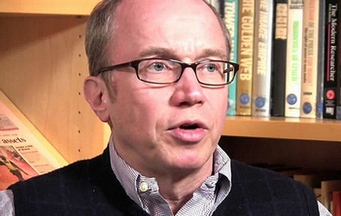 Photo credit: ktsdesign
If you haven't caught this story yet, It is only a few weeks back that all major international newspapers reported of Rupert Murdoch public statements about the days of the free internet business model being over. While speaking on a conference call in which his own News Corporation reported a 47 percent slide in quarterly profits, Murdoch specifically said that "the current free access business model favored by most content providers was flawed." (Source: CNN)
"We are now in the midst of an epochal debate over the value of content and it is clear to many newspapers that the current model is malfunctioning," the News Corp. Chairman and CEO said.
Rupert Murdoch described the present online news commercial approach a "malfunctioning" business model which needs some rapid fixing. And that sparked a new wave of discussions and articles challenging again the eternal question: should online news content be free or should it be charged for?
Even a recent US Senate hearing on the "Future of Journalism" made it clear that there are quite a few newspaper companies who would like to go back to charging for their content (while lobbying for tax breaks at the same time).
But is charging for news content really the solution to newspapers crisis?
If you look beyond the appearances and official statements, the future of online news may actually be quite different from it would appear by just browsing through these story headlines.
As a matter of fact, I think that the very question we are asking is not the right one. It is not whether online news content should be free or paid, but rather which type of news content should benefit the most from being free and which one should drive enthusiastic paid subscriptions without one interfering with the other.
In this video interview, Alan Murray, Executive Editor at the Wall Street Journal, reveals quite a different story and vision from the one we have been hearing over the news. Murray reveals a more balanced strategy in which both free and paid content can play a strategically important role in which the two approaches complement each other rather than being opponents of two opposing extremes.
Here's Alan Murray insightful video interview alongside a full text transcription. If you are wondering whether you should charge or let your news content be free, here some really valuable advice:
Photo credit: ktsdesign
If you haven't caught this story yet, It is only a few weeks back that all major international newspapers reported of Rupert Murdoch public statements about the days of the free internet business model being over. While speaking on a conference call in which his own News Corporation reported a 47 percent slide in quarterly profits, Murdoch specifically said that "the current free access business model favored by most content providers was flawed." (Source: CNN)
"We are now in the midst of an epochal debate over the value of content and it is clear to many newspapers that the current model is malfunctioning," the News Corp. Chairman and CEO said.
Rupert Murdoch described the present online news commercial approach a "malfunctioning" business model which needs some rapid fixing. And that sparked a new wave of discussions and articles challenging again the eternal question: should online news content be free or should it be charged for?
Even a recent US Senate hearing on the "Future of Journalism" made it clear that there are quite a few newspaper companies who would like to go back to charging for their content (while lobbying for tax breaks at the same time).
But is charging for news content really the solution to newspapers crisis?
If you look beyond the appearances and official statements, the future of online news may actually be quite different from it would appear by just browsing through these story headlines.
As a matter of fact, I think that the very question we are asking is not the right one. It is not whether online news content should be free or paid, but rather which type of news content should benefit the most from being free and which one should drive enthusiastic paid subscriptions without one interfering with the other.
In this video interview, Alan Murray, Executive Editor at the Wall Street Journal, reveals quite a different story and vision from the one we have been hearing over the news. Murray reveals a more balanced strategy in which both free and paid content can play a strategically important role in which the two approaches complement each other rather than being opponents of two opposing extremes.
Here's Alan Murray insightful video interview alongside a full text transcription. If you are wondering whether you should charge or let your news content be free, here some really valuable advice:
Alan Murray of The Wall Street Journal On Charging For Content
Duration: 4' 31'' by Alan MurrayFull English Text Transcription
Inside or Outside The Pay Wall
What’s happened in the last year and a half or two years is that we've discovered this is not a binary issue. It’s not pay wall / no pay wall. We’ve put more and more of our content outside of the pay wall. You can get all our political coverage, all our opinion coverage, all our arts and leisure coverage free, available to anybody. A lot of big news stories, even business news stories, the coverage is available free, because we know that if we don’t put it out there you’ll just go to somebody else. If it’s a big news story, if we report a takeover and... we could hold that behind the pay wall. But if we do, BusinessWeek or someone else will simply write a story saying “The Wall Street Journal is reporting x,” and they’ll get all the traffic. Why would we do that? So if it’s that kind of a big, broad-interest news story, we’ll put it outside the pay wall and go ahead and take the traffic ourselves, thank you very much.
The Wall Street Journal and The Google News Experiment
The Google News arrangement was an experiment. We thought, let’s let people who are looking for a story come in and read one story, any one story. Seems to have worked pretty well. When people go to Google News, they’re not, by and large, people who have a relationship with The Wall Street Journal. They’re just looking for the best story on a subject. If we happen to have that story, we let them read it. But if they like it enough that they want to have a relationship with us, if they care about our business and financial coverage, eventually they’ll have to subscribe. In a sense, we’re having our cake and eating it too, by making those clear distinctions between what’s going to be most broadly popular, what’s most likely to attract traffic on the wider web, but keeping in mind what the core value proposition is that we offer to subscribers who come to us for business and financial news they can’t get anywhere else.
Narrow Your Interest
The key is not to take your most popular stuff and put it behind a pay wall. That’s the been the mistake that some people have made in the past: "This is the story that most people want to read; therefore, that’s the one we’re gonna make them pay for." That’s not the right answer. The broad, popular stuff is the stuff you want out in the free world because that drives traffic, that builds up your traffic, and you can, of course, serve advertising to that audience. I think what you have to think about is sort of narrower groups of interest where the interest might be deeper and more intense and therefore might make people willing to pay for it. I had this conversation with one newspaper editor where I said: "Look, what’s your equivalent of our business readers - the group of people who really need to read you because there’s something they desperately care about?" And one of those editors said to me: "It’s really local sports". It’s the high school football game or the high school basketball game. Not necessarily of interest to all the paper’s readers, but to the people who want to read it. They really want to read it because maybe their kids are involved. Maybe they’re willing to pay for that. Or maybe there’s a photography service that’s connected to that where you can download pictures of your kids or of the game. But only if you’re a subscriber. That’s just one example, but I think that’s the kind of thing.
People Will Pay For Value
The truth of the matter is there are tons of people out there paying large amounts of money, billions of dollars, to buy information every day. There were a couple of guys in Texas who started the ultimate news service on the oil business with oil rig counts and all that. They sell it. They’re driving around in Mercedes. Why didn’t The Houston Chronicle do that? Why did that have to be some outsider? The question is to find the information that has an enormous value to not necessarily a big group of people. Maybe it’s a small group of people, but enough value that they’re willing to pay for it. I think those opportunities are out there for lots of newspapers. We’re working on a premium initiative to launch a series of more, as you say, niche or narrower information services that we can sell at a premium to smaller groups of subscribers on subjects that they care most about. Energy might be an example. Obviously a lot of our readers are deeply interested in financial subjects. Perhaps some sort of a news service for chief financial officers. There are a lot of ideas that are on the table. We’ve started prioritizing them, got a few that will probably come out first. But I’m not going to break that news on your video.
Alan Murray's Highlights

- The best content publishing model is a mix of paid and free content.
- The content you don't give out for free will be published elsewhere and you will lose traffic.
- Do not charge your audience for the most popular content you have on your site.
- Target your paid content to highly-focused niches.
Original video of Alan Murray republished with permission of Nieman Journalism Lab. Video transcription prepared by Daniele Bazzano and first published on June 2nd, 2009 as "Online Newspapers Best Content Publishing Strategy: Free Or Paid?"
About the author
 Alan Murray is online executive editor of The Wall Street Journal, and author of the "Business" column, which runs on page 2 every Wednesday. He is also a regular contributor to CNBC, and author of the book “Revolt in the Boardroom: The New Rules of Power in Corporate America”. Mr. Murray has management responsibility for the Journal’s multimedia efforts, including its relationship with CNBC television, the Wall Street Journal books business, the paper’s events business, and a variety of online ventures.
Alan Murray is online executive editor of The Wall Street Journal, and author of the "Business" column, which runs on page 2 every Wednesday. He is also a regular contributor to CNBC, and author of the book “Revolt in the Boardroom: The New Rules of Power in Corporate America”. Mr. Murray has management responsibility for the Journal’s multimedia efforts, including its relationship with CNBC television, the Wall Street Journal books business, the paper’s events business, and a variety of online ventures.
Photo credits: Free vs. Paid Content - adempercem Narrow Your Interest - 3dfoto People Will Pay For Value - Giskard

